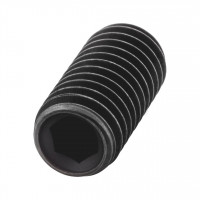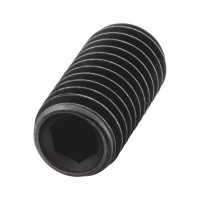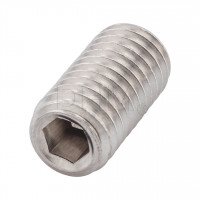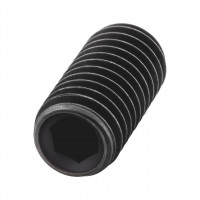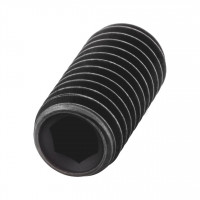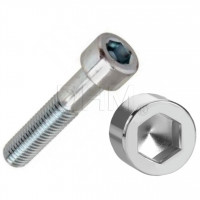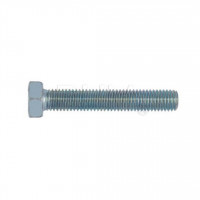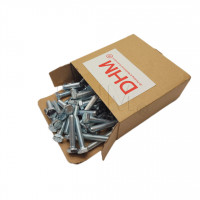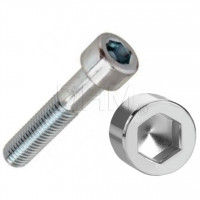The Complexity of Fixings
In the world of mechanical engineering and design, fasteners represent a vast and ever-evolving universe. Screws, in particular, offer an incredible variety of combinations of form, material, geometry and function.
Just by considering variations in head, drive, pitch and materials, billions of different combinations are possible. Therefore, knowing the main types of threads is crucial to choosing the most suitable solution based on materials, loads and operating conditions.
Types of Threads in Screw Connections
1. Screw-Nut Connection
This is the most common and recognizable form of mechanical fastening.
The screw is screwed into a nut or an already threaded part of the component, and during tightening the clamping force is transmitted to the mating materials.
Main characteristics of screws in this category:
-
Head and system of drive: (e.g., cross, hex, Torx, shear).
-
Anti-unscrewing devices : such as integrated washers or specific geometries.
-
Guide bits: reduce the risk of thread damage during screwing.
A practical example is Naviscrew screws, designed with a tip that facilitates alignment in the thread, reducing errors and improving assembly accuracy.
2. Direct Fastening
In direct fastening, the screw creates its own thread in the material, eliminating the need for a pre-existing nut or thread.
This is a versatile solution, widely used in industry and in the production of lightweight or plastic components.
Main applications:
-
Sheet metal screws:
Ideal for steel or aluminum, available in versions:-
for pre-existing holes
-
Self-drilling, with integrated drill bit for drilling and tapping
-
for thin sheets (<1 mm="" strong="">, With optimized geometries to avoid deformation.
-
-
Plastic screws:
Have a deep, spaced thread designed for thermoplastics or thermosets.
Provides high tightness without damaging the material. -
Screws for metallic materials:
Compliant with DIN 7500, they form metric threads during installation and provide a secure, reusable grip.
Advantages and Disadvantages of Systems of Drive
The drive system (or head impression) is the element that enables the transmission of torque to the screw.
The choice of drive internal or external affects automation, accessibility, and fastener life.
Drive internal
✅ Advantages:
-
Compact and lightweight design
-
Ease of automation
-
Wide variety of shapes available
⚠️ Disadvantages:
-
Risk of contamination in dusty or dirty environments
-
Limited transmissible torque in some types (e.g., cross or shear)
Drive external
✅ Advantages:
-
Optimal accessibility even in difficult spaces
-
No risk of internal contamination
⚠️ Disadvantages:
-
Higher weight
-
Need for more space for screwing
Special Screws and Reference Standards
Some screws are designed for specific uses and regulated by DIN or ISO standards to ensure safety and performance.
Examples:
-
Ring screws (DIN 580): used for lifting and handling loads.
-
Screws with integrated security: such as the RIPP LOCK range, which combines mechanical locking functions and ease of assembly.
These solutions are particularly popular in industrial, construction, automotive and machine tool sectors.
How to Choose the Right Thread
Choosing the ideal thread depends on several factors:
-
Componentmaterial (metal, plastic, composite)
-
Anticipated static or dynamicload
-
Operating environment (temperature, vibration, humidity)
-
Frequency of assembly/disassembly
Correctly evaluating these parameters can increase the life of the fastener and reduce maintenance or replacement costs.
Conclusion
There is no such thing as a "universal" screw, but the right combination of characteristics allows for high performance and reliability over time.
Understanding the differences between various types of threads, materials and drive systems is the first step in optimizing manufacturing processes and ensuring safe mechanical connections.
An informed approach to screw selection can make the difference between an efficient assembly and a weak point in the structure.
❓ FAQ on Screw Threads.
What are the main types of threads?
Metric, plastic, sheet metal and self-tapping threads.
What to consider when choosing a screw?
Geometry, type of drive, material and conditions of use.
Are there screws for specific applications?
Yes, such as DIN 580 screws for lifting or RIPP LOCK screws for safety fasteners.






